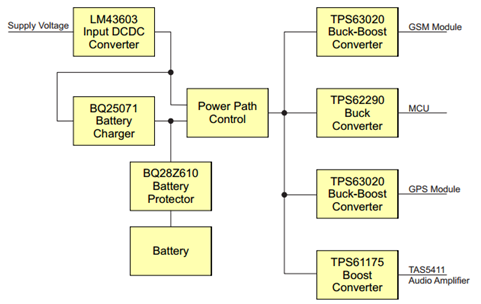SSZTBJ9 march 2016 BQ25071 , BQ28Z610 , CSD25402Q3A , LM43603 , LM43603-Q1 , TAS5411-Q1 , TL331-Q1 , TPS61175-Q1 , TPS62290-Q1 , TPS63020-Q1
The emergency call (eCall) system is a newer electronic subsystem that you’ll be seeing and hearing about much more over the next few years. The continual increase of automobile safety standards has caused numerous governments to investigate requiring eCall systems. In 2018, the European Union (EU) will require an eCall device to be installed in all new vehicles. The eCall system will automatically contact emergency responders in the event of a serious road accident, and wirelessly send airbag deployment and impact sensor information, as well as GPS coordinates to local emergency agencies. Since eCall systems are an entirely new automotive subsystem which must adhere to strict regulations, a complete and dedicated power reference design makes it much easier to design.
Let’s take a look at each block in the TI Designs Automotive eCall Power Supply Reference Design with Low Intermediate Voltage (PMP9769.1), shown in Figure 1.
 Figure 1 Automotive
eCall power supply Block Diagram for eCall Systems
Powered from Low-voltage Backup Batteries
Figure 1 Automotive
eCall power supply Block Diagram for eCall Systems
Powered from Low-voltage Backup BatteriesBackup Battery Selection
Since the car already has a 12V battery, what’s the point of a backup battery? Consider what would happen if you didn’t have the 12V battery and you needed to make an emergency call. Without a backup battery in your eCall system, nothing would happen – no phone call, no GPS finding you, and no emergency vehicles coming to where you are. You might be stranded for days, or worse. This is why a backup battery is critical in eCall systems: to ensure the reliability of a life-or-death system.
The eCall reference design addresses eCall systems with lower-voltage backup batteries, which typically have voltages between 2.5V and 4.5V. Popular battery chemistries include lithium ion, lithium polymer, lithium iron phosphate (LiFePO4), and various nickel chemistries. Three nickel cells produce a stack voltage in the appropriate range, while just one lithium cell produces the same voltage. A compromise between cost, energy density, size and cell voltage, a lithium iron phosphate cell is directly supported with the bq25071 linear charger and bq28Z610 gas gauge used in the reference design. The other power-management devices support different chemistries, but you must find optimal battery-management solutions to use different chemistries.
Car Battery to 5V Rail
A key requirement in any automotive system is protecting lower-voltage electronics from the voltage excursions on the main car battery. In cases where the system uses a lower-voltage backup battery, the 12V nominal car battery must also be stepped down to a more useable level closer to the backup battery voltage. This enables efficient charging of the backup battery without creating excessive heat. The LM43603-Q1 synchronous step-down voltage converter, can create a 5V system rail from the car battery. Even though the LM43603 is a 36V-input rated device and automotive-qualified, it also supports operation above 2MHz to avoid interfering with the AM radio band.
Power Path Control
This circuit ensures an always-powered eCall system, either by the LM43603-Q1 if the car battery is present or by the backup battery. Three CSD25402Q3A p-channel NexFET™ power MOSFETs controlled by a TL331-Q1 comparator provide the system with the highest available voltage.
The power path control block powers the remaining DC/DC converters in the system. These convert the intermediate voltage rail to the exact voltage each load requires.
GSM Module Supply
The Global System for Mobile (GSM) subsystem typically requires around 3.8V to communicate between the car and cellular network. Since the backup-battery voltage varies above and below this level, a buck-boost converter is required. The TPS63020-Q1 buck-boost converter supports the GSM’s required 2A of current as well as switching above the AM radio band at 2.4MHz.
MCU Supply
Every eCall system requires a microcontroller (MCU) for housekeeping, monitoring eCall subsystems and possibly communicating with the car. Other logic circuits typically run off of this same voltage, which is usually 1.8V. Since this voltage is below the intermediate voltage rail voltage, you can use a step-down converter. The TPS62290-Q1 is a small and simple buck converter that operates above the AM radio band at 2.25MHz.
GPS Module Supply
The GPS module requires 5V but at a lower current than the GSM supply. However, since the 5V is at the same voltage as the intermediate voltage rail, a buck-boost converter is also required. Reusing the TPS63020-Q1 in the design keeps the overall bill of materials (BOM) count lower.
Audio Amplifier Supply
Audio amplifier power-supply voltage and current requirements depend greatly on the choice of audio amplifier and the location of the speaker in the car. Speaker location strongly impacts the required output power, which in turn impacts the voltage and current that the audio amplifier requires. In almost all cases, a step-up converter powers the audio amplifier when operating from a low-voltage intermediate voltage rail.
The TAS5411-Q1 audio amplifier provides up to 8W of power and accepts a supply voltage up to 18V. The TPS61175-Q1 boost converter provides the audio amplifier with 9V. The TPS61175-Q1 integrates the main power MOSFET in the boost stage and is programmable to operate up to 2.2MHz, above the AM radio band.
And that’s all you need to power a low-voltage eCall system. How will you use the TI Designs Automotive eCall Power Supply Reference Design with Low Intermediate Voltage to shorten your design time?